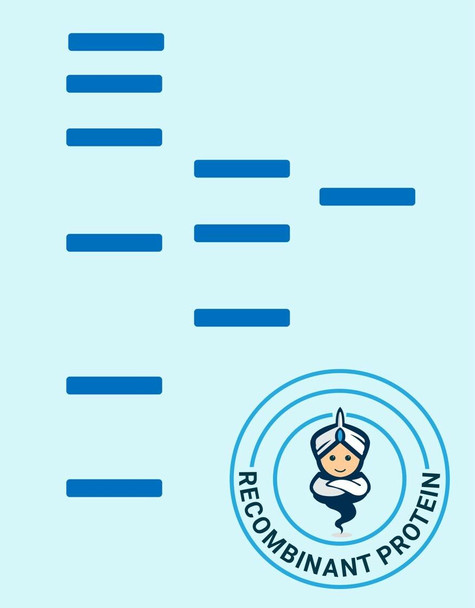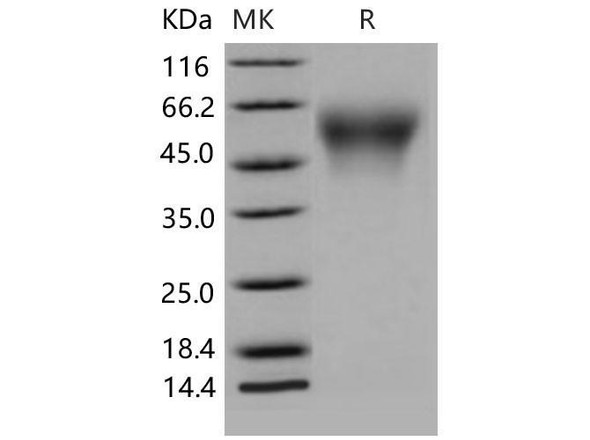Description
| Product Name: | Mouse GRO1/KC Recombinant Protein |
| Product Code: | RPPB1143 |
| Size: | 20µg |
| Species: | Mouse |
| Target: | GRO1/KC |
| Synonyms: | Growth-regulated alpha protein, CXCL1, Platelet-derived growth factor-inducible protein KC, Secretory protein N51, KC, Fsp, N51, gro, Gro1, Mgsa, Scyb1, chemokine (C-X-C motif) ligand 1. |
| Source: | Escherichia Coli |
| Physical Appearance: | Sterile Filtered White lyophilized (freeze-dried) powder. |
| Formulation: | The protein solution (1mg/ml) was lyophilized from 20mM phosphate buffer pH-7.4 and 0.1M NaCl. |
| Solubility: | It is recommended to reconstitute the lyophilized GRO1 Recombinant in sterile 18M?-cm H2O not less than 100�g/ml, which can then be further diluted to other aqueous solutions. |
| Stability: | Lyophilized KC Mouse although stable at room temperature for 3 weeks, should be stored desiccated below -18°C. Upon reconstitution CXCL1 should be stored at 4°C between 2-7 days and for future use below -18°C. For long term storage it is recommended to add a carrier protein (0.1% HSA or BSA).Please prevent freeze-thaw cycles. |
| Purity: | Greater than 97.0% as determined by:(a) Analysis by RP-HPLC.(b) Analysis by SDS-PAGE. |
| Amino Acid Sequence: | APIANELRCQ CLQTMAGIHL KNIQSLKVLP SGPHCTQTEV IATLKNGREA CLDPEAPLVQ KIVQKMLKGV PK |
| Biological Activity: | The biological activity was determined by measuring the ability to chemoattrat human neutrophilsat a concentration of 10ng/ml-100ng/ml. |
Chemokine (C-X-C motif) ligand 1 (CXCL1) is a small cytokine belonging to the CXC chemokine family that was previously called GRO1 oncogene, Neutrophil-activating protein 3 (NAP-3) and melanoma growth stimulating activity, alpha (MSGA-a). It is secreted by human melanoma cells, has mitogenic properties and is implicated in melanoma pathogenesis. CXCL1 is expressed by macrophages, neutrophils and epithelial cells, and has neutrophil chemoattractant activity. CXCL1 plays a role in spinal cord development by inhibiting the migration of oligodendrocyte precursors and is involved in the processes of angiogenesis, inflammation, wound healing, and tumorigenesis. This chemokine elicits its effects by signaling through the chemokine receptor CXCR2. The gene for CXCL1 is located on human chromosome 4 amongst genes for other CXC chemokines.
KC Mouse Recombinant also known as N51 and GRO-1 produced in E.Coli is a single, non-glycosylated, polypeptide chain containing 72 amino acids and having a molecular mass of approximately 7.8 kDa.The GRO-1 is purified by proprietary chromatographic techniques.
| UniProt Protein Function: | CXCL2: Produced by activated monocytes and neutrophils and expressed at sites of inflammation. Hematoregulatory chemokine, which, in vitro, suppresses hematopoietic progenitor cell proliferation. GRO-beta(5-73) shows a highly enhanced hematopoietic activity. Belongs to the intercrine alpha (chemokine CxC) family. |
| UniProt Protein Details: | Protein type:Secreted; Motility/polarity/chemotaxis; Secreted, signal peptide Cellular Component: extracellular space; cell; extracellular region; cytosol Molecular Function:growth factor activity; chemokine activity; CXCR chemokine receptor binding; cytokine activity Biological Process: neutrophil chemotaxis; G-protein coupled receptor protein signaling pathway; elevation of cytosolic calcium ion concentration; response to molecule of bacterial origin; positive regulation of superoxide release; positive regulation of potassium ion transport; response to lipopolysaccharide; immune response; positive regulation of leukocyte chemotaxis; inflammatory response; acute inflammatory response; regulation of cell proliferation |
| NCBI Summary: | This gene encodes a protein that is a member of the CXC subfamily of chemokines. Chemokines, which recruit and activate leukocytes, are classified by function (inflammatory or homeostatic) or by structure. This secretory protein is proposed to bind the G-protein coupled receptor chemokine (C-X-C motif) receptor 2 to recruit neutrophils. In mouse, deficiency of this gene is associated with colitis and with defects in immune cell recruitment to the lung. [provided by RefSeq, Apr 2013] |
| UniProt Code: | P12850 |
| NCBI GenInfo Identifier: | 121623 |
| NCBI Gene ID: | 14825 |
| NCBI Accession: | P12850.1 |
| UniProt Related Accession: | P12850 |
| Molecular Weight: | 10,254 Da |
| NCBI Full Name: | Growth-regulated alpha protein |
| NCBI Synonym Full Names: | chemokine (C-X-C motif) ligand 1 |
| NCBI Official Symbol: | Cxcl1�� |
| NCBI Official Synonym Symbols: | KC; Fsp; N51; gro; Gro1; Mgsa; Scyb1�� |
| NCBI Protein Information: | growth-regulated alpha protein; KC/GR)-alpha; KC/GRO-alpha; GRO1 oncogene; alpha-chemokine; secretory protein N51; C-X-C motif chemokine 1; platelet-derived growth factor-inducible protein KC |
| UniProt Protein Name: | Growth-regulated alpha protein |
| UniProt Synonym Protein Names: | C-X-C motif chemokine 1; Platelet-derived growth factor-inducible protein KC; Secretory protein N51Cleaved into the following chain:KC(5-72)Alternative name(s):Hematopoietic synergistic factor; HSF; KC-T |
| Protein Family: | KCNQ1 downstream neighbor protein |
| UniProt Gene Name: | Cxcl1�� |
| UniProt Entry Name: | GROA_MOUSE |









